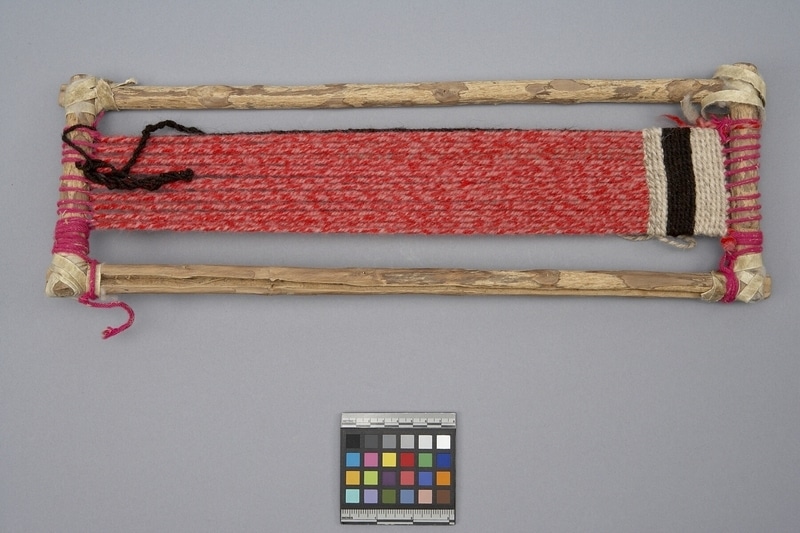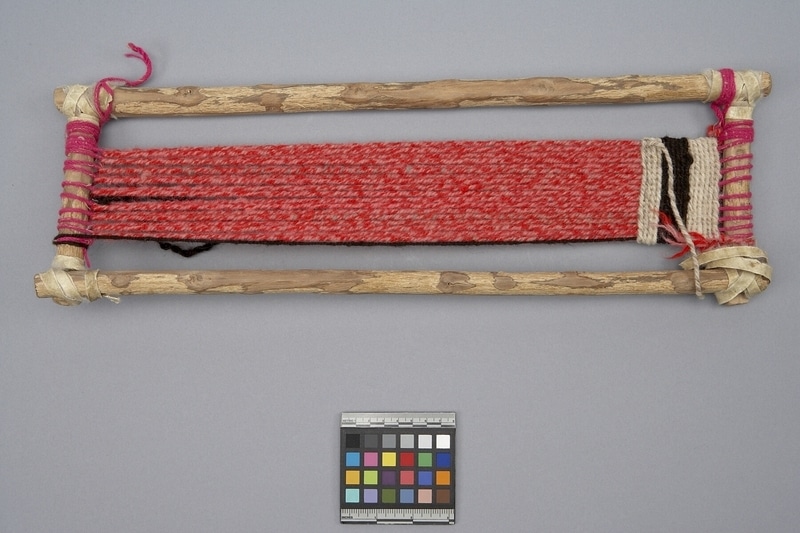Model Loom Item Number: Sf950 from the MOA: University of British Columbia


Description
A rectangular loom with an incomplete fabric attached. The loom is made of four slightly smoothed sticks lashed together with strips of sheep-hide. The mottled red warps are lashed to each end bar with separate cords. Thick grey and black striped fabric is at one end of the taut; closely spaced warps. A length of grey and black weft yarn is still attached.
History Of Use
Men use a loom approximately four times the size of this model, on which to weave the stiff under belt which is attached and worn under wide red belts. The under belt acts as a back support and is used during heavy labour. It also keeps the red belt smooth and attractive. The weft wrapped structure and the four selvedges of the underbelt are characteristics found in pre-colombian fabrics.
Narrative
The model was made by Gonzalo Yucra Huatta specifically for the Museum to document this fabric making technique. The full size loom is used in a variety of positions: across the lap or slanting from the knees to the ground while sitting or kneeling.
Specific Techniques
Warp yarns are a replied combination of commercial wool or synthetic yarns. Several strands each of red and pink s-plied yarns are plied together z, then 3 of these are replied s. The black handspun wool weft is z spun and plied 2-s. The grey handspun wool weft is z spun and plied 3-s. The lashing cords are made of re-twisted commercial yarns of synthetic fibre which are replied 6-z. The fabric structure is weft wrapping, sometimes called soumale. The fabric would have 4 selvages when complete and would be used in its loom shape.
Cultural Context
weaving
Item History
- Made by Gonzalo Yucra Huatta (Maker) in Taquile, Puno, Peru before 1983
- Collected by Mary Frame during 1983
- Owned by Mary Frame before October 27, 1983
- Received from Mary Frame (Seller) and Museum of Anthropology Shop Volunteers (Funding source) on October 27, 1983
What
- Name
- Model Loom
- Identification Number
- Sf950
- Type of Item
- loom
- Material
- wool fibre, synthetic fibre, wood and skin
- Manufacturing Technique
- spun, plied, lashed and wrapped
- Overall
- height 49.6 cm, width 15.6 cm, depth 6.7 cm
Who
- Culture
- Quechua
- Creator
- Gonzalo Yucra Huatta (Maker)
- Field Collector
- Mary Frame
- Previous Owner
- Mary Frame
- Received from
- Mary Frame (Seller) and Museum of Anthropology Shop Volunteers (Funding source)
Where
- Holding Institution
- MOA: University of British Columbia
- Made in
- Taquile, Puno, Peru
When
- Creation Date
- before 1983
- Collection Date
- during 1983
- Ownership Date
- before October 27, 1983
- Acquisition Date
- on October 27, 1983
Other
- Item Classes
- textiles
- Condition
- fair
- Accession Number
- 0948/0079